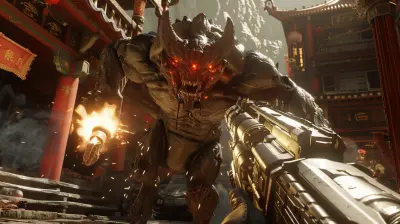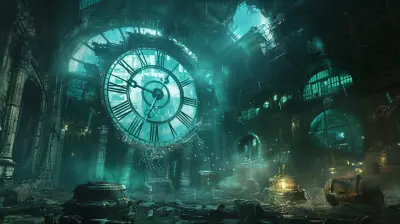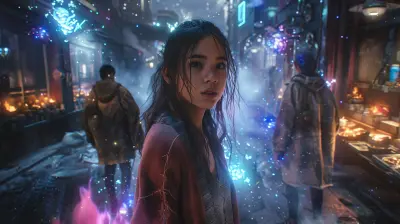Why Restrictive Playstyles Bring Out Creative Strategy
13 August 2025
Ever been dropped into a game with limited weapons, minimal resources, or an absurd rule that makes you question your life choices? Yeah, the kind of gameplay that leaves you shouting at your screen — but somehow, you keep coming back for more. That, my fellow gamer, is the magic of restrictive playstyles.
Sounds crazy, right? But hear me out.
While it might feel like shackles at first, limitations in games don’t suffocate creativity—they ignite it. When the easy way is off-limits, the brain kicks into overdrive, cooking up brilliant, wacky, and sometimes downright genius workarounds.
Let’s dive into why these frustrating (yet strangely addicting) playstyles are actually a goldmine for creative strategy.
What Do We Mean by “Restrictive Playstyles”?
Before we go berserk with examples, let’s define the beast.A restrictive playstyle is any way of playing a game that adds constraints—whether self-imposed or built into the game itself. Think...
- Pacifist runs in action-heavy games.
- Hardcore modes with permadeath and no saves.
- No magic builds in fantasy RPGs.
- Speedruns where you’re shaving off frames like your life depends on it.
- Using only one weapon, or even... a frying pan.
These restrictions force you to think differently. You can’t rely on brute strength or traditional mechanics. Suddenly, every move is calculated. Every choice matters.
And that’s where creativity shines like a critical hit at 1 HP.
The Paradox of Limitation: Less = More
At first glance, restrictions seem like they would stunt your growth as a player. But in reality, they do the opposite.Let’s be real: when everything is available to you, the temptation to pick the most overpowered strategy is strong. Why experiment when meta builds do the job, right?
But when restrictions kick in, the mental gears begin to turn. You start poking at game mechanics. Testing boundaries. Looping around rules. You transform from a player into a strategist.
Think of it like chess. If you suddenly lose your queen, do you lose the match? Not necessarily. You adapt. You start thinking six steps ahead. You tap into skills you didn’t even know you had.
Real-Life Examples That Show It Works
Still not convinced? Let’s break down some iconic examples where limitation unlocked a treasure chest of creativity.1. The “No-Hit” Runs in Dark Souls
Ah yes, Dark Souls. The game that turns grown adults into quivering wrecks. Now imagine beating it without taking a single hit.Why would anyone do that?
Because it turns the game into a dance of precision. Players who take on this challenge aren’t just playing; they’re mastering. You become deeply aware of enemy patterns, attack windows, and timing. Instead of tanking hits, you weave through chaos like a shadow.
It’s not about brute force—it’s about finesse.
2. Minecraft Hardcore Mode
Minecraft may look like digital LEGO, but flip on Hardcore Mode and it turns into survival chess.One life. No respawns. No mercy.
Now, players can’t just YOLO into creeper nests. They plan. They strategize. They innovate structures for safety, design redstone contraptions to automate survival, and map out every journey with military-level logistics.
The same game that once encouraged sandbox freedom now demands delicate balance and raw ingenuity.
3. Pokémon Nuzlocke Challenges
The Nuzlocke Challenge slams rules onto a game known for being... kind of easy.- Faint = death (release your Pokémon if it faints)
- Only catch the first Pokémon you encounter in each area
- Nickname every creature
Suddenly, your fluffy team of overpowered monsters becomes a ragtag band of underdogs you genuinely care about. You form new strategies, bond with your team, and pray you don’t lose your MVP to a random crit.
Restrictive? Painfully so. Fun? 100%.
Why Our Brains LOVE Solving Puzzles
Let’s step away from games for a sec and talk psychology.Ever notice how you light up when you finally figure out a tough puzzle? That’s your brain getting a sweet dopamine hit. Humans are wired to solve problems. We like structure—even if we pretend we don’t.
When we’re boxed in, instead of panicking, our minds search for cracks in the wall. We look for loopholes, shortcuts, and alternate paths. That’s how we grow.
Restrictive playstyles turn games into puzzles. Not the “move this block onto that switch” kind, but the “How do I beat this boss with a stick and some hope?” kind.
Freedom Can Be Overwhelming
Here’s the thing. Too much freedom can actually kill creativity.Ever open up a blank page and just… stare at it?
That’s the paradox of choice. With infinite options, making decisions gets harder. You’re paralyzed by possibilities.
Restrictions act like bumpers that guide creativity down a focused path. They provide a framework—a creative sandbox, if you will.
Think of it like cooking with limited ingredients. You don’t have a giant pantry? Cool. Now you’re playing "Chopped" in your own kitchen, mixing unexpected flavors and creating magic.
Games are no different.
Player-Driven Restrictions: The Value of Self-Imposed Limits
Here’s where it gets juicy. Some of the most creative strategies in gaming didn’t come from devs—they came from players who said:“What if I tried to beat this game… without doing X?”
These self-imposed challenges are where legends are born. They keep old games fresh, build communities around shared suffering, and showcase the wild depth some players are willing to explore.
Ever watch a “Can You Beat Skyrim With Only A Fork?” video? Same energy.
Restriction Builds Mastery
There’s another killer benefit: mastery.When you limit your options, you get really good at using what you have. Instead of spreading thin across all mechanics, you deep-dive into a focused strategy.
It’s why speedrunners get absurdly efficient. Or why fighting game players who stick to one character can pull off god-tier combos that make your jaw drop.
Restriction forces you to specialize. And mastering a narrow skillset often leads to surprising versatility because you understand mechanics on a deeper level.
The Community Aspect: Challenges That Go Viral
Let’s not forget how restrictions fuel content and community engagement.Think of:
- “Permadeath runs”
- “Only using Pistols” challenges
- “No HUD” survival playthroughs
These aren’t just personal goals—they become social events. Streamed, shared, and celebrated. Entire fandoms rally around these challenges, offering tips, laughs, and mutual trauma bonds.
Restrictions don’t isolate—they connect.
Developers Know This (And They Use It)
This isn’t lost on game developers. In fact, many build these limitations into their games deliberately.- Roguelikes: Every run is a random gauntlet of pain.
- Ironman Modes: No checkpoints, just pure commitment.
- Limited Loadouts: Encouraging experimentation over power gaming.
Why? Because they know constraints bring the kind of engagement that keeps players coming back. When you can’t storm in swinging, you start thinking. Planning. Getting creative.
They want to push you to your creative limits—and sometimes, your sanity.
The Psychological High of Beating the Odds
Let’s be honest: Winning with full gear and all abilities feels good.But winning after struggling? Pulling off the impossible with one health, no ammo, and a toothpick? That hits different.
When you beat a game under a restrictive playstyle, it’s not just a win—it’s a story. A badge of honor. The kind of experience you tell your friends about for years.
And that emotional high? It’s addictive.
Final Thoughts: Embrace the Chains
So next time a game restricts you—or you decide to restrict yourself—don’t roll your eyes.Embrace it. Wrestle with it. Get weird with your strategies. Try a stealth play in a shooty game. Rock a mage build with zero spells. Speedrun a slow-paced sim title just for the chaos.
Why? Because that’s where the magic happens.
Restrictions aren’t roadblocks. They’re secret portals to creativity.
And some of the most memorable moments in gaming?
They’re born when you're backed into a corner… and come out swinging.
all images in this post were generated using AI tools
Category:
Game ChallengesAuthor:

Stephanie Abbott
Discussion
rate this article
1 comments
Karson Pacheco
Great insights! Embracing restrictions can indeed spark innovative strategies. It's fascinating how limitations can fuel creativity in gameplay.
August 27, 2025 at 2:56 AM

Stephanie Abbott
Thank you! I completely agree—limitations often push us to think outside the box and discover new strategies.


